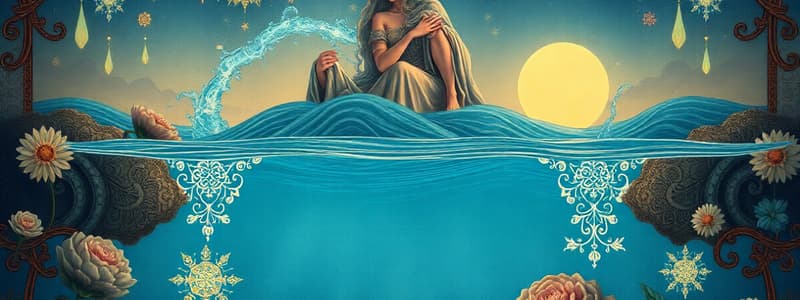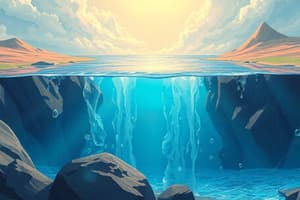Podcast
Questions and Answers
Which of the following best describes the role of plants in an ecosystem?
Which of the following best describes the role of plants in an ecosystem?
- They produce energy-rich compounds from sunlight, carbon dioxide, and water. (correct)
- They regulate the population sizes of other organisms.
- They break down dead organisms, releasing nutrients back into the environment.
- They consume other organisms for energy.
What is the primary role of decomposers in an ecosystem's food web?
What is the primary role of decomposers in an ecosystem's food web?
- To consume primary producers.
- To provide shelter for other organisms.
- To break down dead organisms and recycle nutrients. (correct)
- To produce energy from sunlight.
Which process describes the conversion of water from a liquid to a gaseous state?
Which process describes the conversion of water from a liquid to a gaseous state?
- Evaporation (correct)
- Sublimation
- Precipitation
- Condensation
In the water cycle, what term describes water falling back to earth in the form of rain, snow, or hail?
In the water cycle, what term describes water falling back to earth in the form of rain, snow, or hail?
How does the process of photosynthesis contribute to the carbon cycle?
How does the process of photosynthesis contribute to the carbon cycle?
What is the effect of increased carbon dioxide levels in the atmosphere on the Earth's temperature?
What is the effect of increased carbon dioxide levels in the atmosphere on the Earth's temperature?
Why is the term 'biological diversity' important in the context of ecosystems?
Why is the term 'biological diversity' important in the context of ecosystems?
What is the main reason that animals are classified as consumers in an ecosystem?
What is the main reason that animals are classified as consumers in an ecosystem?
What is the direct effect of deforestation on the carbon cycle?
What is the direct effect of deforestation on the carbon cycle?
If a forest ecosystem experiences a prolonged drought, which of the following is the most likely immediate consequence for the food web?
If a forest ecosystem experiences a prolonged drought, which of the following is the most likely immediate consequence for the food web?
What process occurs when water vapor changes into a liquid?
What process occurs when water vapor changes into a liquid?
What role do green plants play with respect to carbon dioxide?
What role do green plants play with respect to carbon dioxide?
What is the name of the process by which plants convert light energy into chemical energy?
What is the name of the process by which plants convert light energy into chemical energy?
Which of the following helps to reduce carbon dioxide levels in the atmosphere?
Which of the following helps to reduce carbon dioxide levels in the atmosphere?
Which part of the water cycle involves the transformation of water from a liquid to a gaseous state?
Which part of the water cycle involves the transformation of water from a liquid to a gaseous state?
Which of the following defines the term 'biological diversity'?
Which of the following defines the term 'biological diversity'?
What substance is produced during photosynthesis?
What substance is produced during photosynthesis?
When organic matter burns, what substance is produced?
When organic matter burns, what substance is produced?
What name is given to animals who consume parts of the world around them in order to gain sustenance?
What name is given to animals who consume parts of the world around them in order to gain sustenance?
Water falling due to the effects of gravity is known as?
Water falling due to the effects of gravity is known as?
Flashcards
What is evaporation?
What is evaporation?
Water changing from a liquid to a gas.
What is condensation?
What is condensation?
Water vapor turns into liquid water, forming clouds.
What is precipitation?
What is precipitation?
Water falling back to earth in the form of rain, snow, or hail.
What is photosynthesis?
What is photosynthesis?
Signup and view all the flashcards
What is cell respiration?
What is cell respiration?
Signup and view all the flashcards
What is the greenhouse effect?
What is the greenhouse effect?
Signup and view all the flashcards
What are greenhouse gases?
What are greenhouse gases?
Signup and view all the flashcards
What is a food web?
What is a food web?
Signup and view all the flashcards
What are producers?
What are producers?
Signup and view all the flashcards
Who are consumers?
Who are consumers?
Signup and view all the flashcards
What is biodiversity?
What is biodiversity?
Signup and view all the flashcards
What is ecology?
What is ecology?
Signup and view all the flashcards
What is a species?
What is a species?
Signup and view all the flashcards
What is population?
What is population?
Signup and view all the flashcards
What is an ecosystem?
What is an ecosystem?
Signup and view all the flashcards
What are biotic factors?
What are biotic factors?
Signup and view all the flashcards
What are abiotic factors?
What are abiotic factors?
Signup and view all the flashcards
Who are a Herbivore?
Who are a Herbivore?
Signup and view all the flashcards
Who are a Carnivore?
Who are a Carnivore?
Signup and view all the flashcards
Study Notes
Vattenmolekylens kretslopp
- Havsvatten består av vattenmolekyler.
- Solen värmer upp havsvattnet, vilket ger vattenmolekylerna fart.
- En del av dessa vattenmolekyler avdunstar och blir till vattenånga (gasform).
- Avdunstning sker inte bara från hav, sjöar och floder, utan även från mark, växter och djur.
- Vattenånga stiger, och temperaturen sjunker ju högre upp i luften den kommer.
- När vattenångan kyls ner tillräckligt, kondenserar den till flytande form.
- Vid kondensering rör sig vattenmolekylerna långsammare och binder sig till varandra.
- Detta bildar små vattendroppar som blir till moln.
- När dropparna i molnen blir tillräckligt stora och tunga, faller de ner som regn, snö eller hagel.
- Detta kallas för nederbörd.
- En del av regnet återvänder till havet via växter och djur eller direkt via marken.
- Tiden det tar för vattenmolekyler att nå havet varierar.
- Ytvatten i sjöar och floder når snabbt havet igen.
- Grundvatten kan ta allt från några år till tusentals år för att nå havet.
- Vattenmolekyler som faller som snö och is kan ta mycket lång tid eller aldrig nå havet.
- Vattnet i atmosfären byts ut snabbt, regn är sällan mer än några dagar eller veckor.
Fotosyntes
- Växter behöver energi för att leva och växa.
- Solen är en energigivare, växterna är energitagare.
- Gröna växter kan utnyttja solljus genom fotosyntes.
- Fotosyntesen sker i klorofyllkorn i växternas blad.
- Klorofyll hjälper växterna att ta upp solenergi.
- Med hjälp av solenergi skapar växterna socker av koldioxid och vatten.
- Sockret förbränns sedan och ger energi till växtens celler.
- Klyvöppningar på bladen möjliggör upptag av koldioxid och utsläpp av syre.
- Växter tar upp vatten och näringsämnen via rötterna.
- Energi och näringsämnen är essentiella för alla organismer.
- Rötterna håller fast växterna i marken.
Cellandning
- Djur får sin energi från växter eller andra djur.
- Nedbrytare äter döda växt- och djurdelar.
- Födan bryts ner, och energin som finns lagrad i den tas tillvara.
- Djur kan inte ta upp solens energi själva eftersom de saknar klorofyllkorn.
- För att bryta ner födan och få energi behövs syre.
- Samtidigt bildas koldioxid och vatten.
- Denna process kallas för förbränning eller cellandning.
- Cellandning sker i alla celler, även i växternas.
Förbränning
- Förbränning innebär att energi omvandlas från en form till en annan.
- Exempel på förbränning är när ett ljus brinner, en bil kör eller celler jobbar.
- Energi som är lagrad i ett ämne omvandlas till ljus, rörelse eller värmeenergi.
- I en bensindriven bil förbränns bensinen i motorn och den lagrade energin används för att driva motorn.
- Förbränning sker också i kroppen.
- Energin i maten förbränns i cellerna för att ge värme och rörelseenergi.
- Cellandning är den förbränning som sker i levande organismers celler.
- Vid cellandning bildas koldioxid och vatten.
Växthuseffekten
- Atmosfären är ett luftlager runt jorden.
- Solenergin värmer upp jordytan, som i sin tur sänder ut värmestrålning.
- En del av värmestrålningen fångas upp av gaser i atmosfären som gör att temperaturen ökar på jorden.
- Denna process kallas för växthuseffekt.
- Exempel på växthusgaser är vattenånga och koldioxid.
- Mängden växthusgaser påverkar temperaturen på jorden.
- Mänskliga aktiviteter som bilkörning och industriutsläpp har ökat mängden växthusgaser som koldioxid i atmosfären.
- Ökade halter av koldioxid kan leda till att det blir varmare på jorden.
- Koldioxid bildas vid förbränning.
- Kolatomerna i drivmedlet reagerar med syre och då bildas koldioxid.
- Ökad mängd koldioxid kan hindra värme från att stråla ut i rymden.
- För att undvika detta måste vi förhindra att halterna av växthusgaser ökar.
- Ett sätt är att minska utsläppen.
- Ett annat är att öka skogsarealerna, eftersom träd binder koldioxid.
Näringskedjor och den biologiska mångfalden
- För att förstå hållbar utveckling behöver vi beskriva hur olika arter samverkar.
- En näringsväv visar hur växter, djur och andra levande organismer är beroende av varandra.
- Pilarna i väven pekar mot den som äter.
- Växterna är producenter eftersom de tillverkar näringen.
- Djuren är konsumenter som äter växter eller andra djur.
- Alla konsumenter är beroende av producenterna.
- Biologisk mångfald beskriver mångfalden av levande organismer, variationen inom en art och variationen av ekosystem.
- De flesta länder är överens om att bevara den biologiska mångfalden.
Viktiga ord inom ekologi
- Ekologi: läran om samspelet mellan växter, djur och deras miljö.
- Ekologer: människor som arbetar med ekologi.
- Organism: en levande varelse, en växt, ett djur eller en bakterie.
- Art: en grupp djur eller växter som kan få barn som i sin tur kan få barn.
- Population: en grupp individer av en art inom ett visst område vid en viss tid.
- Ekosystem: ett avgränsat område i naturen, t.ex. en skog eller en vattenpöl.
- Biotiska faktorer: levande saker (växter och djur) som påverkar ett ekosystem.
- Abiotiska faktorer: icke-levande faktorer som påverkar naturen (sol, vind, nederbörd).
- Habitat: en miljö där en viss växtart eller djurart lever.
- Ekologisk nisch: en arts uppgift i ett ekosystem, en miljö som arten trivs i.
- Producent: gröna växter som kan bilda socker (näring) av solljus.
- Konsument: djur som måste äta för att få näring.
- Nedbrytare/destruent: svampar, bakterier, maskar, insekter som bryter ner döda växter och djur.
- Näringskedja: visar vem som äter vem i ett ekosystem.
- Näringsväv: flera näringskedjor ihopvävda i ett ekosystem.
- Växtätare: djur som äter växter.
- Rovdjur: djur som äter andra djur.
Studying That Suits You
Use AI to generate personalized quizzes and flashcards to suit your learning preferences.




